Legal Structures of UK Business Organisations: A Detailed Report
VerifiedAdded on 2023/06/12
|10
|2656
|314
Report
AI Summary
This report provides a detailed analysis of business organizations in the UK, focusing on their legal structures. It begins by defining a company under the Companies Act, 1956, and outlines the key characteristics of a company, including incorporated association, artificial legal body, separate legal existence, perpetual succession, common seal, limited liability, transferable shares, separate property, delegation of power, and the importance of the Memorandum and Articles of Association. The report then categorizes business organizations into sole traders, general partnerships, corporations, and limited liability enterprises, explaining their formation, taxation, liabilities, dissolution, advantages, and disadvantages. It also offers specific recommendations for the International Organization for Migration (IOM) Solutions, suggesting that a sole proprietorship or limited liability company would be the most suitable structure due to the flexibility and control they offer. The report concludes by summarizing the key findings and emphasizing the importance of understanding the legal framework for business operations in the UK.

Business
Organisations
Organisations
Paraphrase This Document
Need a fresh take? Get an instant paraphrase of this document with our AI Paraphraser
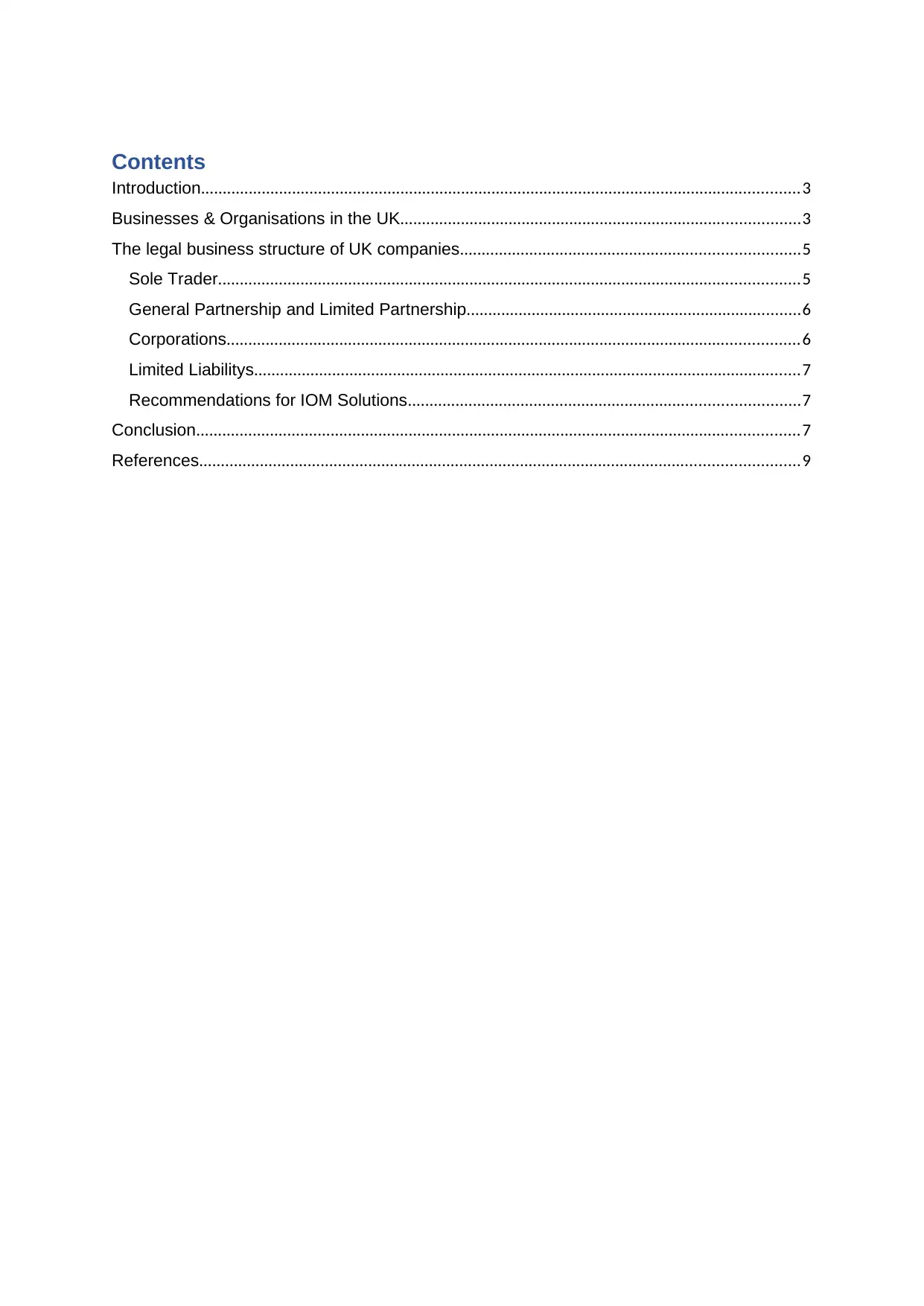
Contents
Introduction..........................................................................................................................................3
Businesses & Organisations in the UK............................................................................................3
The legal business structure of UK companies..............................................................................5
Sole Trader......................................................................................................................................5
General Partnership and Limited Partnership.............................................................................6
Corporations....................................................................................................................................6
Limited Liabilitys..............................................................................................................................7
Recommendations for IOM Solutions..........................................................................................7
Conclusion...........................................................................................................................................7
References..........................................................................................................................................9
Introduction..........................................................................................................................................3
Businesses & Organisations in the UK............................................................................................3
The legal business structure of UK companies..............................................................................5
Sole Trader......................................................................................................................................5
General Partnership and Limited Partnership.............................................................................6
Corporations....................................................................................................................................6
Limited Liabilitys..............................................................................................................................7
Recommendations for IOM Solutions..........................................................................................7
Conclusion...........................................................................................................................................7
References..........................................................................................................................................9
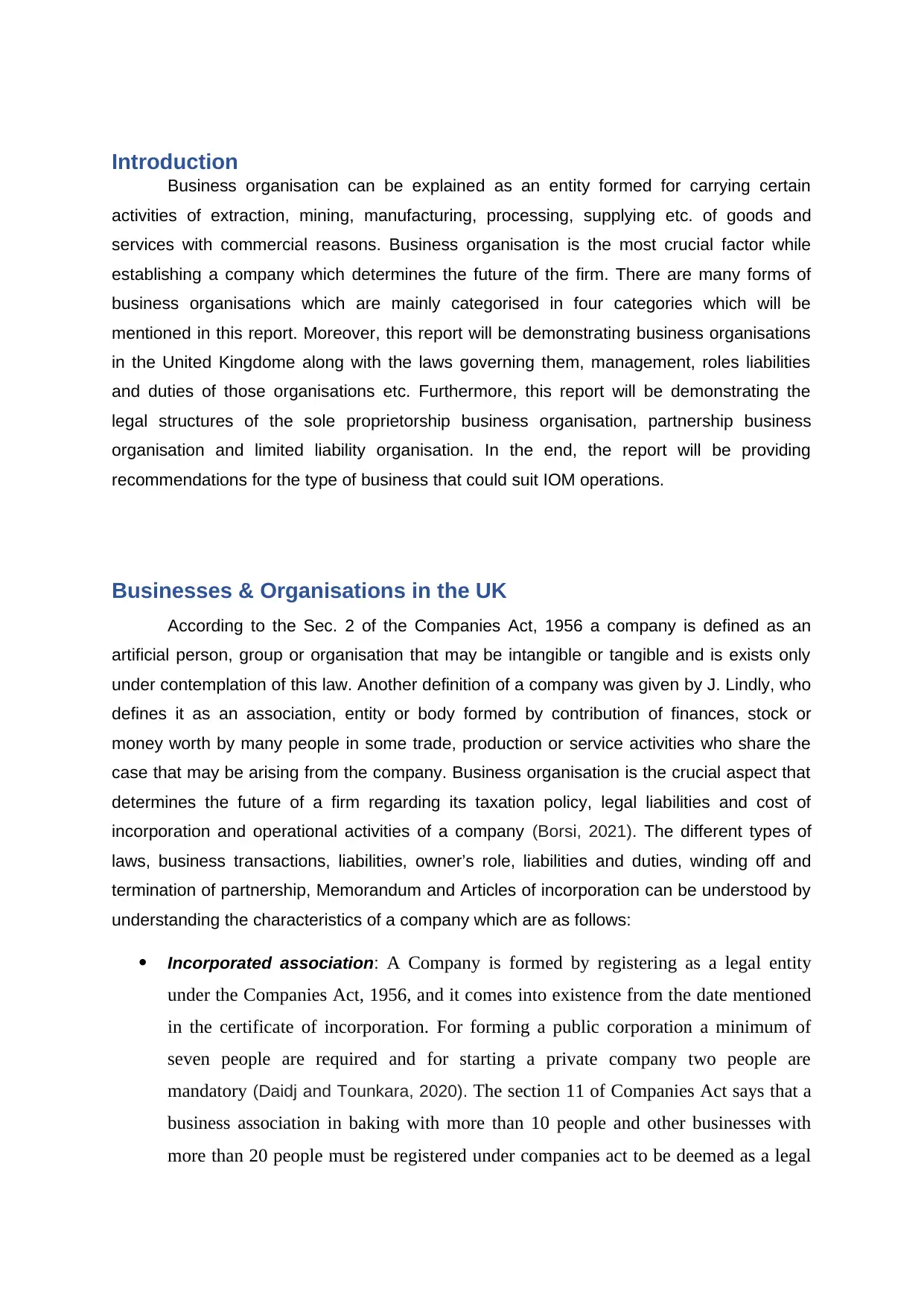
Introduction
Business organisation can be explained as an entity formed for carrying certain
activities of extraction, mining, manufacturing, processing, supplying etc. of goods and
services with commercial reasons. Business organisation is the most crucial factor while
establishing a company which determines the future of the firm. There are many forms of
business organisations which are mainly categorised in four categories which will be
mentioned in this report. Moreover, this report will be demonstrating business organisations
in the United Kingdome along with the laws governing them, management, roles liabilities
and duties of those organisations etc. Furthermore, this report will be demonstrating the
legal structures of the sole proprietorship business organisation, partnership business
organisation and limited liability organisation. In the end, the report will be providing
recommendations for the type of business that could suit IOM operations.
Businesses & Organisations in the UK
According to the Sec. 2 of the Companies Act, 1956 a company is defined as an
artificial person, group or organisation that may be intangible or tangible and is exists only
under contemplation of this law. Another definition of a company was given by J. Lindly, who
defines it as an association, entity or body formed by contribution of finances, stock or
money worth by many people in some trade, production or service activities who share the
case that may be arising from the company. Business organisation is the crucial aspect that
determines the future of a firm regarding its taxation policy, legal liabilities and cost of
incorporation and operational activities of a company (Borsi, 2021). The different types of
laws, business transactions, liabilities, owner’s role, liabilities and duties, winding off and
termination of partnership, Memorandum and Articles of incorporation can be understood by
understanding the characteristics of a company which are as follows:
Incorporated association: A Company is formed by registering as a legal entity
under the Companies Act, 1956, and it comes into existence from the date mentioned
in the certificate of incorporation. For forming a public corporation a minimum of
seven people are required and for starting a private company two people are
mandatory (Daidj and Tounkara, 2020). The section 11 of Companies Act says that a
business association in baking with more than 10 people and other businesses with
more than 20 people must be registered under companies act to be deemed as a legal
Business organisation can be explained as an entity formed for carrying certain
activities of extraction, mining, manufacturing, processing, supplying etc. of goods and
services with commercial reasons. Business organisation is the most crucial factor while
establishing a company which determines the future of the firm. There are many forms of
business organisations which are mainly categorised in four categories which will be
mentioned in this report. Moreover, this report will be demonstrating business organisations
in the United Kingdome along with the laws governing them, management, roles liabilities
and duties of those organisations etc. Furthermore, this report will be demonstrating the
legal structures of the sole proprietorship business organisation, partnership business
organisation and limited liability organisation. In the end, the report will be providing
recommendations for the type of business that could suit IOM operations.
Businesses & Organisations in the UK
According to the Sec. 2 of the Companies Act, 1956 a company is defined as an
artificial person, group or organisation that may be intangible or tangible and is exists only
under contemplation of this law. Another definition of a company was given by J. Lindly, who
defines it as an association, entity or body formed by contribution of finances, stock or
money worth by many people in some trade, production or service activities who share the
case that may be arising from the company. Business organisation is the crucial aspect that
determines the future of a firm regarding its taxation policy, legal liabilities and cost of
incorporation and operational activities of a company (Borsi, 2021). The different types of
laws, business transactions, liabilities, owner’s role, liabilities and duties, winding off and
termination of partnership, Memorandum and Articles of incorporation can be understood by
understanding the characteristics of a company which are as follows:
Incorporated association: A Company is formed by registering as a legal entity
under the Companies Act, 1956, and it comes into existence from the date mentioned
in the certificate of incorporation. For forming a public corporation a minimum of
seven people are required and for starting a private company two people are
mandatory (Daidj and Tounkara, 2020). The section 11 of Companies Act says that a
business association in baking with more than 10 people and other businesses with
more than 20 people must be registered under companies act to be deemed as a legal
⊘ This is a preview!⊘
Do you want full access?
Subscribe today to unlock all pages.

Trusted by 1+ million students worldwide
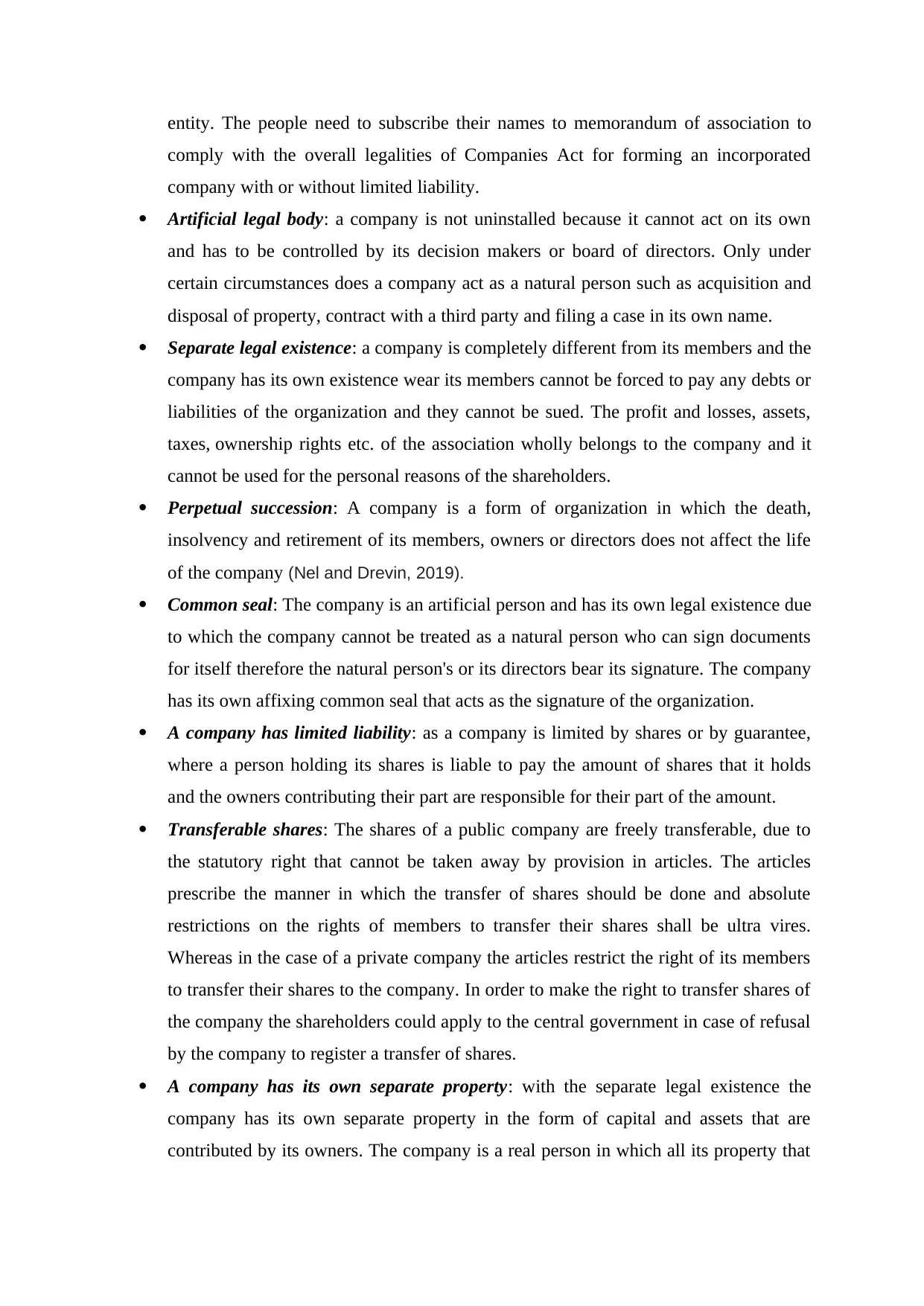
entity. The people need to subscribe their names to memorandum of association to
comply with the overall legalities of Companies Act for forming an incorporated
company with or without limited liability.
Artificial legal body: a company is not uninstalled because it cannot act on its own
and has to be controlled by its decision makers or board of directors. Only under
certain circumstances does a company act as a natural person such as acquisition and
disposal of property, contract with a third party and filing a case in its own name.
Separate legal existence: a company is completely different from its members and the
company has its own existence wear its members cannot be forced to pay any debts or
liabilities of the organization and they cannot be sued. The profit and losses, assets,
taxes, ownership rights etc. of the association wholly belongs to the company and it
cannot be used for the personal reasons of the shareholders.
Perpetual succession: A company is a form of organization in which the death,
insolvency and retirement of its members, owners or directors does not affect the life
of the company (Nel and Drevin, 2019).
Common seal: The company is an artificial person and has its own legal existence due
to which the company cannot be treated as a natural person who can sign documents
for itself therefore the natural person's or its directors bear its signature. The company
has its own affixing common seal that acts as the signature of the organization.
A company has limited liability: as a company is limited by shares or by guarantee,
where a person holding its shares is liable to pay the amount of shares that it holds
and the owners contributing their part are responsible for their part of the amount.
Transferable shares: The shares of a public company are freely transferable, due to
the statutory right that cannot be taken away by provision in articles. The articles
prescribe the manner in which the transfer of shares should be done and absolute
restrictions on the rights of members to transfer their shares shall be ultra vires.
Whereas in the case of a private company the articles restrict the right of its members
to transfer their shares to the company. In order to make the right to transfer shares of
the company the shareholders could apply to the central government in case of refusal
by the company to register a transfer of shares.
A company has its own separate property: with the separate legal existence the
company has its own separate property in the form of capital and assets that are
contributed by its owners. The company is a real person in which all its property that
comply with the overall legalities of Companies Act for forming an incorporated
company with or without limited liability.
Artificial legal body: a company is not uninstalled because it cannot act on its own
and has to be controlled by its decision makers or board of directors. Only under
certain circumstances does a company act as a natural person such as acquisition and
disposal of property, contract with a third party and filing a case in its own name.
Separate legal existence: a company is completely different from its members and the
company has its own existence wear its members cannot be forced to pay any debts or
liabilities of the organization and they cannot be sued. The profit and losses, assets,
taxes, ownership rights etc. of the association wholly belongs to the company and it
cannot be used for the personal reasons of the shareholders.
Perpetual succession: A company is a form of organization in which the death,
insolvency and retirement of its members, owners or directors does not affect the life
of the company (Nel and Drevin, 2019).
Common seal: The company is an artificial person and has its own legal existence due
to which the company cannot be treated as a natural person who can sign documents
for itself therefore the natural person's or its directors bear its signature. The company
has its own affixing common seal that acts as the signature of the organization.
A company has limited liability: as a company is limited by shares or by guarantee,
where a person holding its shares is liable to pay the amount of shares that it holds
and the owners contributing their part are responsible for their part of the amount.
Transferable shares: The shares of a public company are freely transferable, due to
the statutory right that cannot be taken away by provision in articles. The articles
prescribe the manner in which the transfer of shares should be done and absolute
restrictions on the rights of members to transfer their shares shall be ultra vires.
Whereas in the case of a private company the articles restrict the right of its members
to transfer their shares to the company. In order to make the right to transfer shares of
the company the shareholders could apply to the central government in case of refusal
by the company to register a transfer of shares.
A company has its own separate property: with the separate legal existence the
company has its own separate property in the form of capital and assets that are
contributed by its owners. The company is a real person in which all its property that
Paraphrase This Document
Need a fresh take? Get an instant paraphrase of this document with our AI Paraphraser
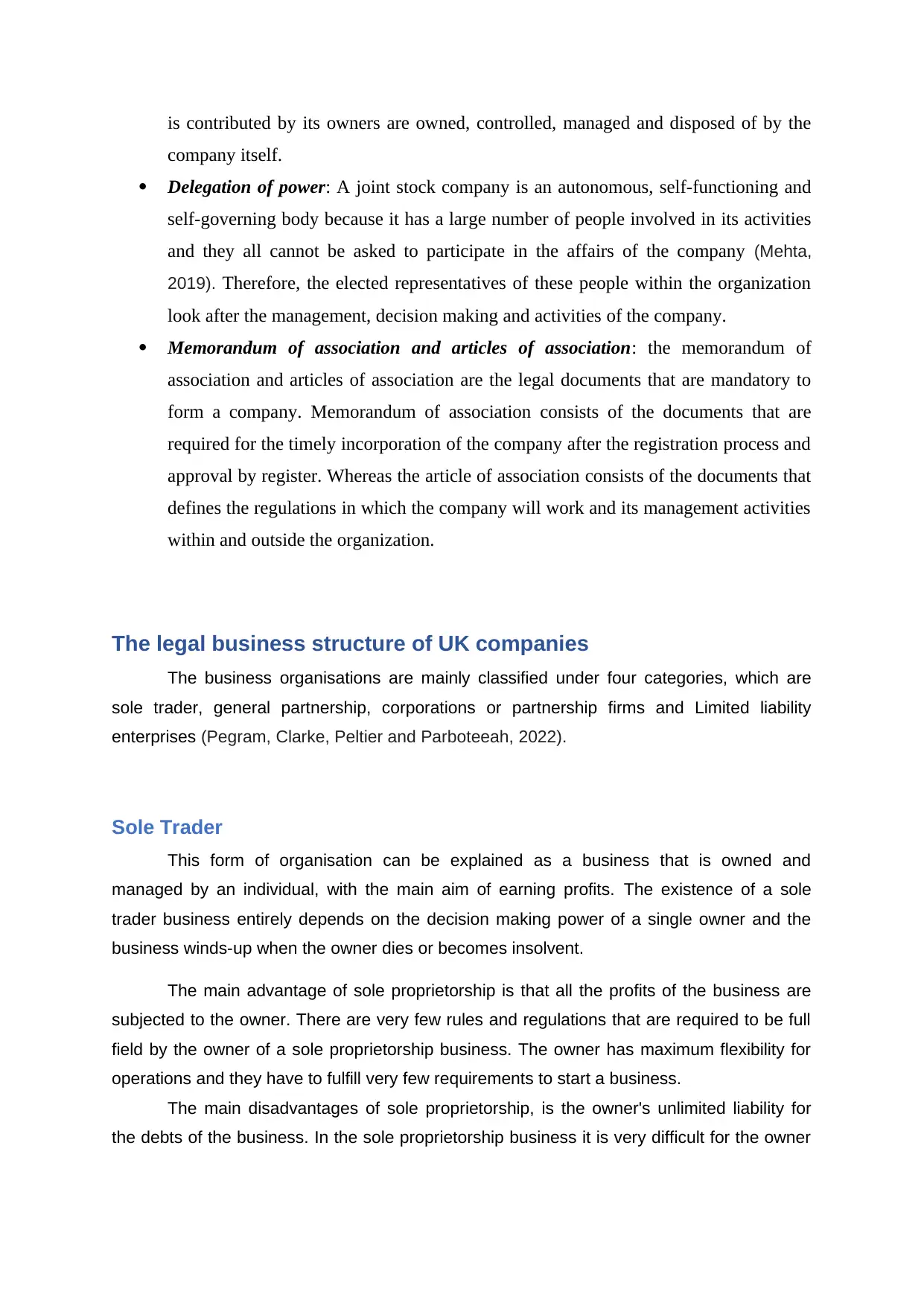
is contributed by its owners are owned, controlled, managed and disposed of by the
company itself.
Delegation of power: A joint stock company is an autonomous, self-functioning and
self-governing body because it has a large number of people involved in its activities
and they all cannot be asked to participate in the affairs of the company (Mehta,
2019). Therefore, the elected representatives of these people within the organization
look after the management, decision making and activities of the company.
Memorandum of association and articles of association: the memorandum of
association and articles of association are the legal documents that are mandatory to
form a company. Memorandum of association consists of the documents that are
required for the timely incorporation of the company after the registration process and
approval by register. Whereas the article of association consists of the documents that
defines the regulations in which the company will work and its management activities
within and outside the organization.
The legal business structure of UK companies
The business organisations are mainly classified under four categories, which are
sole trader, general partnership, corporations or partnership firms and Limited liability
enterprises (Pegram, Clarke, Peltier and Parboteeah, 2022).
Sole Trader
This form of organisation can be explained as a business that is owned and
managed by an individual, with the main aim of earning profits. The existence of a sole
trader business entirely depends on the decision making power of a single owner and the
business winds-up when the owner dies or becomes insolvent.
The main advantage of sole proprietorship is that all the profits of the business are
subjected to the owner. There are very few rules and regulations that are required to be full
field by the owner of a sole proprietorship business. The owner has maximum flexibility for
operations and they have to fulfill very few requirements to start a business.
The main disadvantages of sole proprietorship, is the owner's unlimited liability for
the debts of the business. In the sole proprietorship business it is very difficult for the owner
company itself.
Delegation of power: A joint stock company is an autonomous, self-functioning and
self-governing body because it has a large number of people involved in its activities
and they all cannot be asked to participate in the affairs of the company (Mehta,
2019). Therefore, the elected representatives of these people within the organization
look after the management, decision making and activities of the company.
Memorandum of association and articles of association: the memorandum of
association and articles of association are the legal documents that are mandatory to
form a company. Memorandum of association consists of the documents that are
required for the timely incorporation of the company after the registration process and
approval by register. Whereas the article of association consists of the documents that
defines the regulations in which the company will work and its management activities
within and outside the organization.
The legal business structure of UK companies
The business organisations are mainly classified under four categories, which are
sole trader, general partnership, corporations or partnership firms and Limited liability
enterprises (Pegram, Clarke, Peltier and Parboteeah, 2022).
Sole Trader
This form of organisation can be explained as a business that is owned and
managed by an individual, with the main aim of earning profits. The existence of a sole
trader business entirely depends on the decision making power of a single owner and the
business winds-up when the owner dies or becomes insolvent.
The main advantage of sole proprietorship is that all the profits of the business are
subjected to the owner. There are very few rules and regulations that are required to be full
field by the owner of a sole proprietorship business. The owner has maximum flexibility for
operations and they have to fulfill very few requirements to start a business.
The main disadvantages of sole proprietorship, is the owner's unlimited liability for
the debts of the business. In the sole proprietorship business it is very difficult for the owner
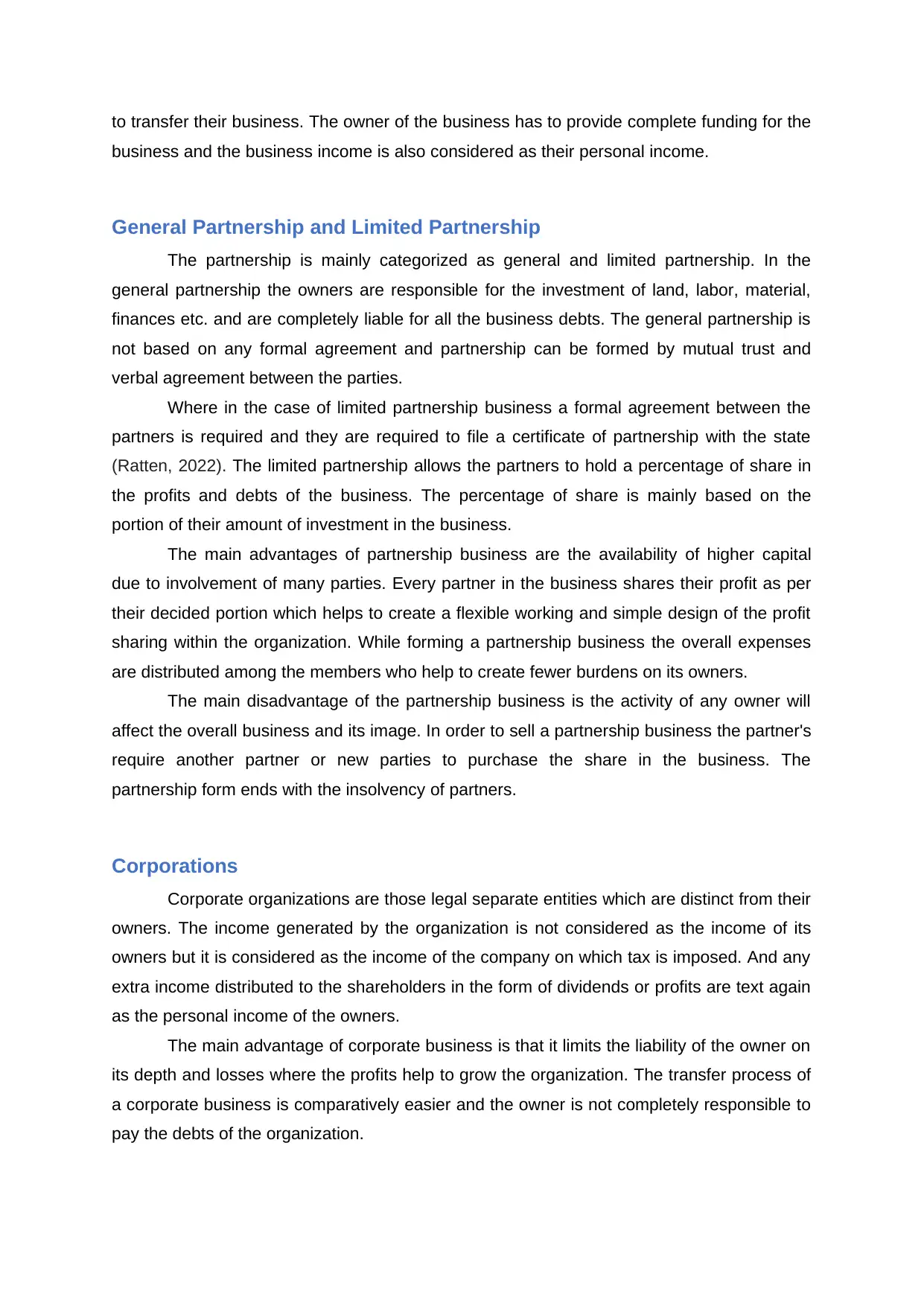
to transfer their business. The owner of the business has to provide complete funding for the
business and the business income is also considered as their personal income.
General Partnership and Limited Partnership
The partnership is mainly categorized as general and limited partnership. In the
general partnership the owners are responsible for the investment of land, labor, material,
finances etc. and are completely liable for all the business debts. The general partnership is
not based on any formal agreement and partnership can be formed by mutual trust and
verbal agreement between the parties.
Where in the case of limited partnership business a formal agreement between the
partners is required and they are required to file a certificate of partnership with the state
(Ratten, 2022). The limited partnership allows the partners to hold a percentage of share in
the profits and debts of the business. The percentage of share is mainly based on the
portion of their amount of investment in the business.
The main advantages of partnership business are the availability of higher capital
due to involvement of many parties. Every partner in the business shares their profit as per
their decided portion which helps to create a flexible working and simple design of the profit
sharing within the organization. While forming a partnership business the overall expenses
are distributed among the members who help to create fewer burdens on its owners.
The main disadvantage of the partnership business is the activity of any owner will
affect the overall business and its image. In order to sell a partnership business the partner's
require another partner or new parties to purchase the share in the business. The
partnership form ends with the insolvency of partners.
Corporations
Corporate organizations are those legal separate entities which are distinct from their
owners. The income generated by the organization is not considered as the income of its
owners but it is considered as the income of the company on which tax is imposed. And any
extra income distributed to the shareholders in the form of dividends or profits are text again
as the personal income of the owners.
The main advantage of corporate business is that it limits the liability of the owner on
its depth and losses where the profits help to grow the organization. The transfer process of
a corporate business is comparatively easier and the owner is not completely responsible to
pay the debts of the organization.
business and the business income is also considered as their personal income.
General Partnership and Limited Partnership
The partnership is mainly categorized as general and limited partnership. In the
general partnership the owners are responsible for the investment of land, labor, material,
finances etc. and are completely liable for all the business debts. The general partnership is
not based on any formal agreement and partnership can be formed by mutual trust and
verbal agreement between the parties.
Where in the case of limited partnership business a formal agreement between the
partners is required and they are required to file a certificate of partnership with the state
(Ratten, 2022). The limited partnership allows the partners to hold a percentage of share in
the profits and debts of the business. The percentage of share is mainly based on the
portion of their amount of investment in the business.
The main advantages of partnership business are the availability of higher capital
due to involvement of many parties. Every partner in the business shares their profit as per
their decided portion which helps to create a flexible working and simple design of the profit
sharing within the organization. While forming a partnership business the overall expenses
are distributed among the members who help to create fewer burdens on its owners.
The main disadvantage of the partnership business is the activity of any owner will
affect the overall business and its image. In order to sell a partnership business the partner's
require another partner or new parties to purchase the share in the business. The
partnership form ends with the insolvency of partners.
Corporations
Corporate organizations are those legal separate entities which are distinct from their
owners. The income generated by the organization is not considered as the income of its
owners but it is considered as the income of the company on which tax is imposed. And any
extra income distributed to the shareholders in the form of dividends or profits are text again
as the personal income of the owners.
The main advantage of corporate business is that it limits the liability of the owner on
its depth and losses where the profits help to grow the organization. The transfer process of
a corporate business is comparatively easier and the owner is not completely responsible to
pay the debts of the organization.
⊘ This is a preview!⊘
Do you want full access?
Subscribe today to unlock all pages.

Trusted by 1+ million students worldwide
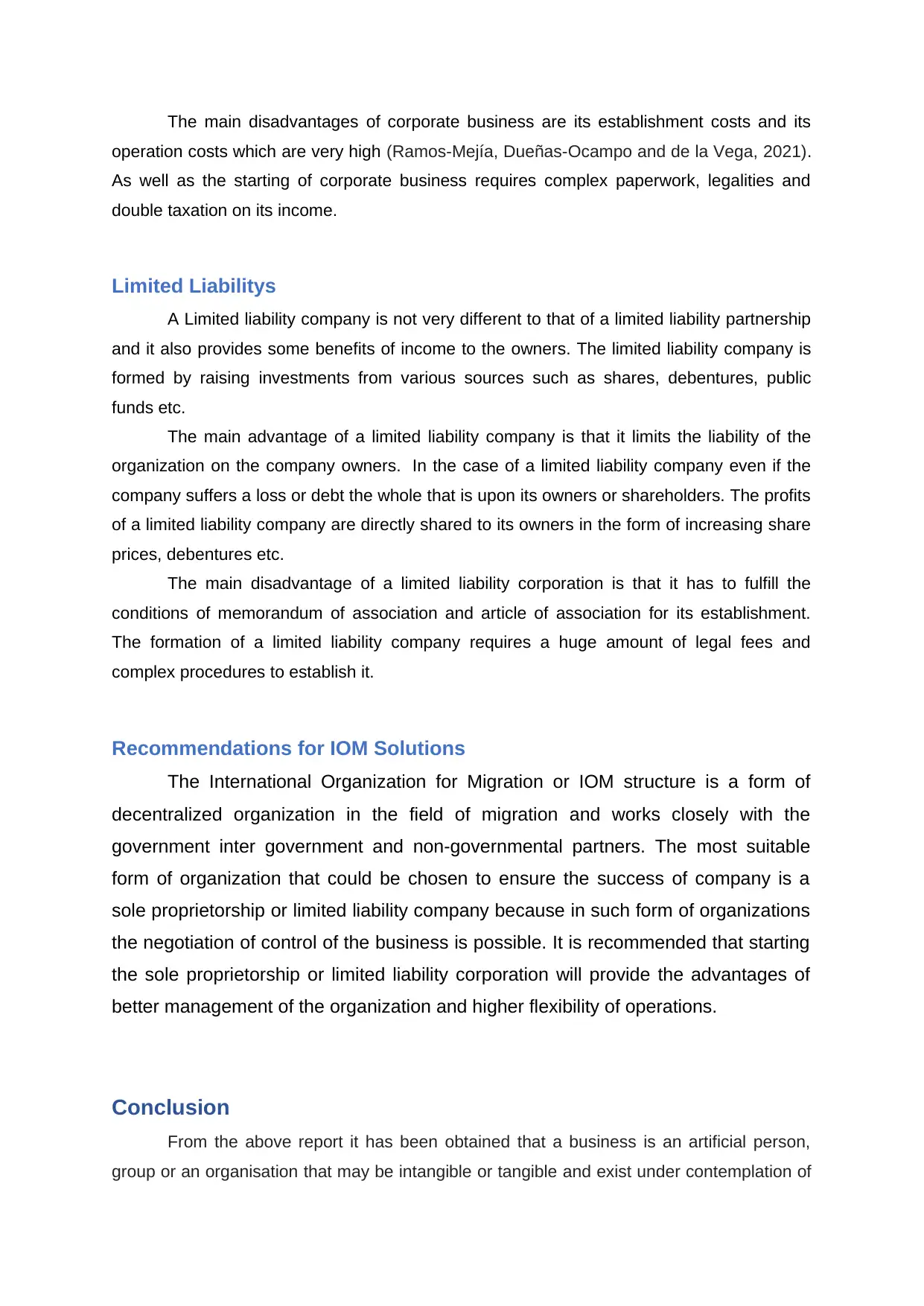
The main disadvantages of corporate business are its establishment costs and its
operation costs which are very high (Ramos-Mejía, Dueñas-Ocampo and de la Vega, 2021).
As well as the starting of corporate business requires complex paperwork, legalities and
double taxation on its income.
Limited Liabilitys
A Limited liability company is not very different to that of a limited liability partnership
and it also provides some benefits of income to the owners. The limited liability company is
formed by raising investments from various sources such as shares, debentures, public
funds etc.
The main advantage of a limited liability company is that it limits the liability of the
organization on the company owners. In the case of a limited liability company even if the
company suffers a loss or debt the whole that is upon its owners or shareholders. The profits
of a limited liability company are directly shared to its owners in the form of increasing share
prices, debentures etc.
The main disadvantage of a limited liability corporation is that it has to fulfill the
conditions of memorandum of association and article of association for its establishment.
The formation of a limited liability company requires a huge amount of legal fees and
complex procedures to establish it.
Recommendations for IOM Solutions
The International Organization for Migration or IOM structure is a form of
decentralized organization in the field of migration and works closely with the
government inter government and non-governmental partners. The most suitable
form of organization that could be chosen to ensure the success of company is a
sole proprietorship or limited liability company because in such form of organizations
the negotiation of control of the business is possible. It is recommended that starting
the sole proprietorship or limited liability corporation will provide the advantages of
better management of the organization and higher flexibility of operations.
Conclusion
From the above report it has been obtained that a business is an artificial person,
group or an organisation that may be intangible or tangible and exist under contemplation of
operation costs which are very high (Ramos-Mejía, Dueñas-Ocampo and de la Vega, 2021).
As well as the starting of corporate business requires complex paperwork, legalities and
double taxation on its income.
Limited Liabilitys
A Limited liability company is not very different to that of a limited liability partnership
and it also provides some benefits of income to the owners. The limited liability company is
formed by raising investments from various sources such as shares, debentures, public
funds etc.
The main advantage of a limited liability company is that it limits the liability of the
organization on the company owners. In the case of a limited liability company even if the
company suffers a loss or debt the whole that is upon its owners or shareholders. The profits
of a limited liability company are directly shared to its owners in the form of increasing share
prices, debentures etc.
The main disadvantage of a limited liability corporation is that it has to fulfill the
conditions of memorandum of association and article of association for its establishment.
The formation of a limited liability company requires a huge amount of legal fees and
complex procedures to establish it.
Recommendations for IOM Solutions
The International Organization for Migration or IOM structure is a form of
decentralized organization in the field of migration and works closely with the
government inter government and non-governmental partners. The most suitable
form of organization that could be chosen to ensure the success of company is a
sole proprietorship or limited liability company because in such form of organizations
the negotiation of control of the business is possible. It is recommended that starting
the sole proprietorship or limited liability corporation will provide the advantages of
better management of the organization and higher flexibility of operations.
Conclusion
From the above report it has been obtained that a business is an artificial person,
group or an organisation that may be intangible or tangible and exist under contemplation of
Paraphrase This Document
Need a fresh take? Get an instant paraphrase of this document with our AI Paraphraser
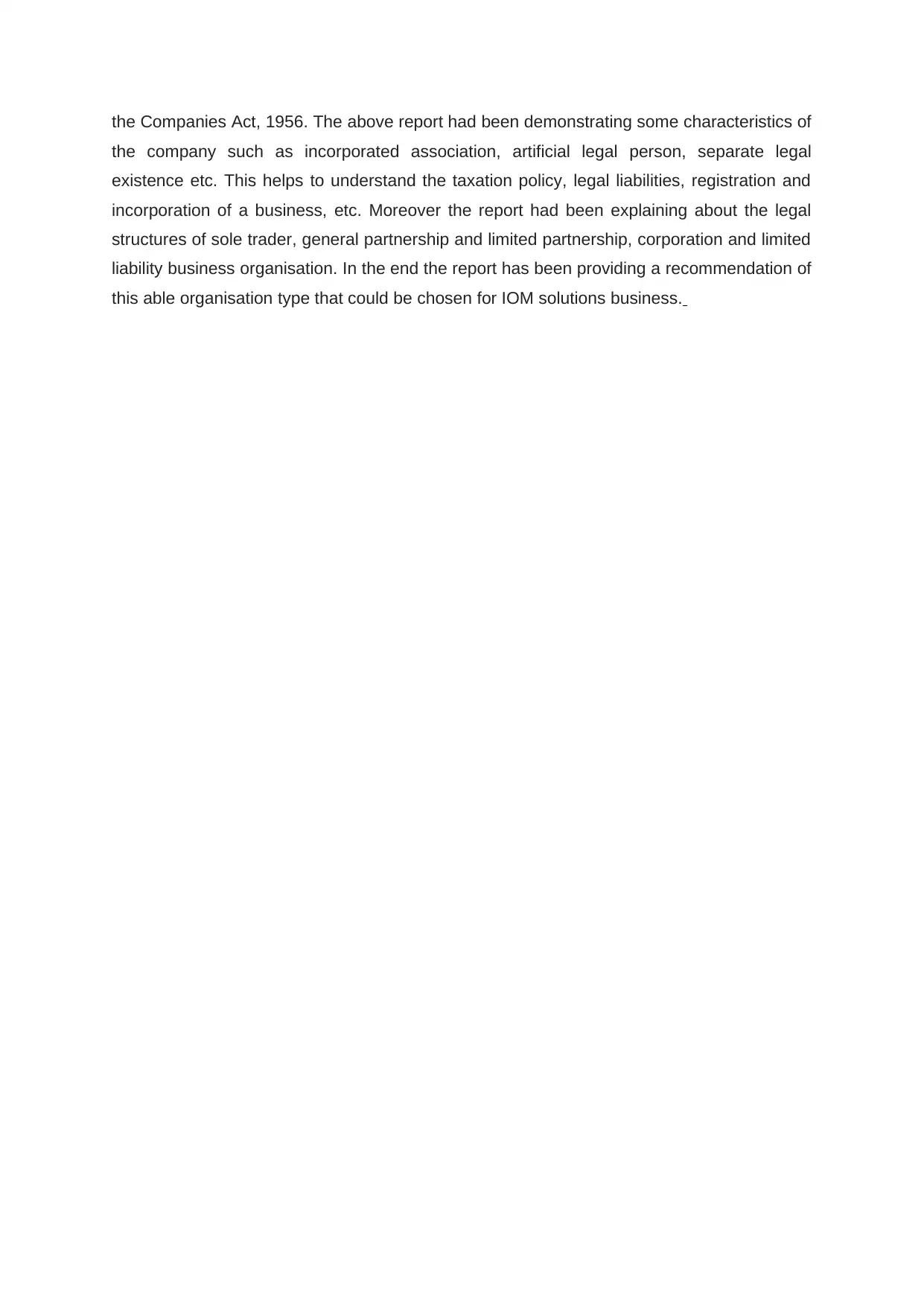
the Companies Act, 1956. The above report had been demonstrating some characteristics of
the company such as incorporated association, artificial legal person, separate legal
existence etc. This helps to understand the taxation policy, legal liabilities, registration and
incorporation of a business, etc. Moreover the report had been explaining about the legal
structures of sole trader, general partnership and limited partnership, corporation and limited
liability business organisation. In the end the report has been providing a recommendation of
this able organisation type that could be chosen for IOM solutions business.
the company such as incorporated association, artificial legal person, separate legal
existence etc. This helps to understand the taxation policy, legal liabilities, registration and
incorporation of a business, etc. Moreover the report had been explaining about the legal
structures of sole trader, general partnership and limited partnership, corporation and limited
liability business organisation. In the end the report has been providing a recommendation of
this able organisation type that could be chosen for IOM solutions business.
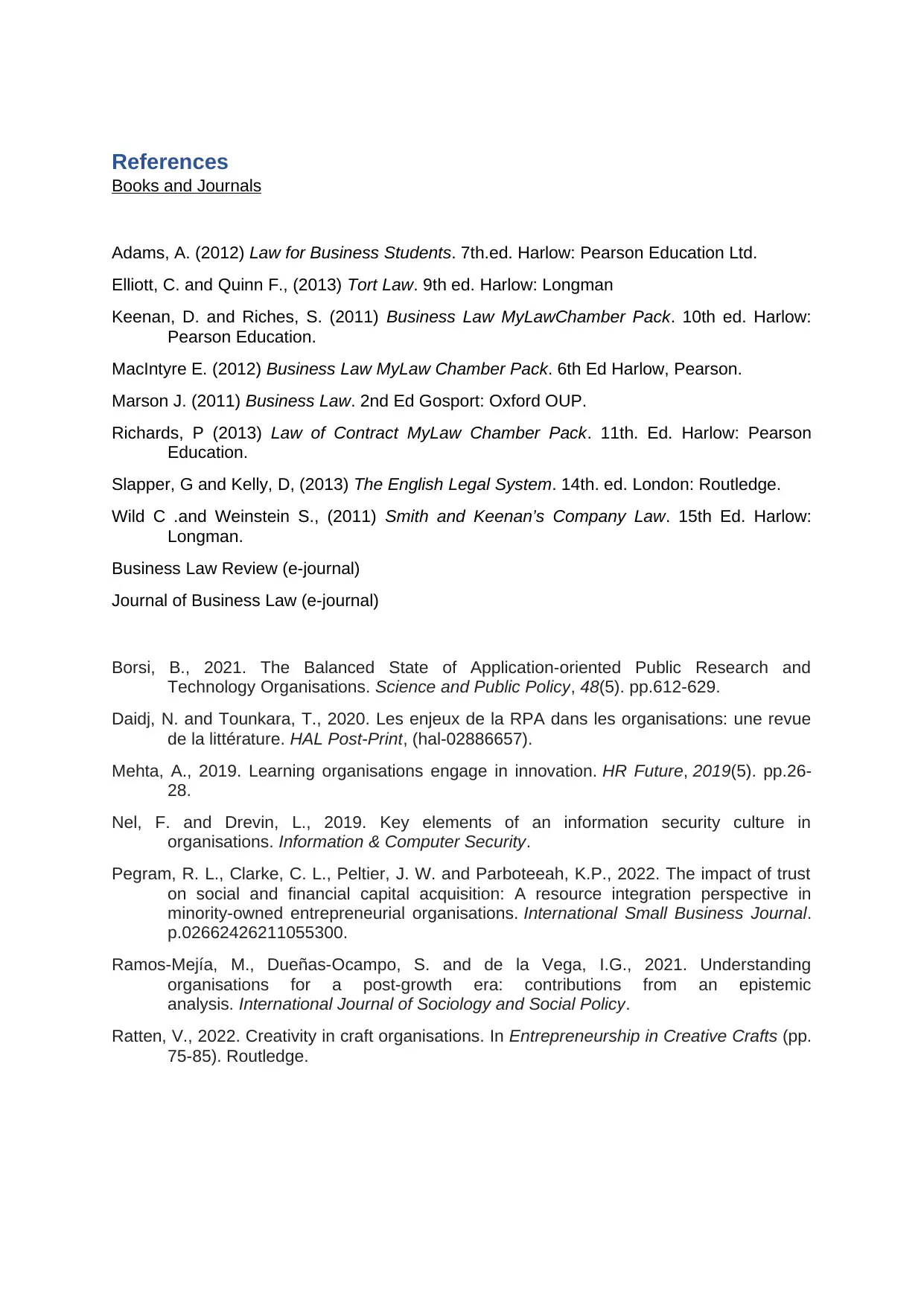
References
Books and Journals
Adams, A. (2012) Law for Business Students. 7th.ed. Harlow: Pearson Education Ltd.
Elliott, C. and Quinn F., (2013) Tort Law. 9th ed. Harlow: Longman
Keenan, D. and Riches, S. (2011) Business Law MyLawChamber Pack. 10th ed. Harlow:
Pearson Education.
MacIntyre E. (2012) Business Law MyLaw Chamber Pack. 6th Ed Harlow, Pearson.
Marson J. (2011) Business Law. 2nd Ed Gosport: Oxford OUP.
Richards, P (2013) Law of Contract MyLaw Chamber Pack. 11th. Ed. Harlow: Pearson
Education.
Slapper, G and Kelly, D, (2013) The English Legal System. 14th. ed. London: Routledge.
Wild C .and Weinstein S., (2011) Smith and Keenan’s Company Law. 15th Ed. Harlow:
Longman.
Business Law Review (e-journal)
Journal of Business Law (e-journal)
Borsi, B., 2021. The Balanced State of Application-oriented Public Research and
Technology Organisations. Science and Public Policy, 48(5). pp.612-629.
Daidj, N. and Tounkara, T., 2020. Les enjeux de la RPA dans les organisations: une revue
de la littérature. HAL Post-Print, (hal-02886657).
Mehta, A., 2019. Learning organisations engage in innovation. HR Future, 2019(5). pp.26-
28.
Nel, F. and Drevin, L., 2019. Key elements of an information security culture in
organisations. Information & Computer Security.
Pegram, R. L., Clarke, C. L., Peltier, J. W. and Parboteeah, K.P., 2022. The impact of trust
on social and financial capital acquisition: A resource integration perspective in
minority-owned entrepreneurial organisations. International Small Business Journal.
p.02662426211055300.
Ramos-Mejía, M., Dueñas-Ocampo, S. and de la Vega, I.G., 2021. Understanding
organisations for a post-growth era: contributions from an epistemic
analysis. International Journal of Sociology and Social Policy.
Ratten, V., 2022. Creativity in craft organisations. In Entrepreneurship in Creative Crafts (pp.
75-85). Routledge.
Books and Journals
Adams, A. (2012) Law for Business Students. 7th.ed. Harlow: Pearson Education Ltd.
Elliott, C. and Quinn F., (2013) Tort Law. 9th ed. Harlow: Longman
Keenan, D. and Riches, S. (2011) Business Law MyLawChamber Pack. 10th ed. Harlow:
Pearson Education.
MacIntyre E. (2012) Business Law MyLaw Chamber Pack. 6th Ed Harlow, Pearson.
Marson J. (2011) Business Law. 2nd Ed Gosport: Oxford OUP.
Richards, P (2013) Law of Contract MyLaw Chamber Pack. 11th. Ed. Harlow: Pearson
Education.
Slapper, G and Kelly, D, (2013) The English Legal System. 14th. ed. London: Routledge.
Wild C .and Weinstein S., (2011) Smith and Keenan’s Company Law. 15th Ed. Harlow:
Longman.
Business Law Review (e-journal)
Journal of Business Law (e-journal)
Borsi, B., 2021. The Balanced State of Application-oriented Public Research and
Technology Organisations. Science and Public Policy, 48(5). pp.612-629.
Daidj, N. and Tounkara, T., 2020. Les enjeux de la RPA dans les organisations: une revue
de la littérature. HAL Post-Print, (hal-02886657).
Mehta, A., 2019. Learning organisations engage in innovation. HR Future, 2019(5). pp.26-
28.
Nel, F. and Drevin, L., 2019. Key elements of an information security culture in
organisations. Information & Computer Security.
Pegram, R. L., Clarke, C. L., Peltier, J. W. and Parboteeah, K.P., 2022. The impact of trust
on social and financial capital acquisition: A resource integration perspective in
minority-owned entrepreneurial organisations. International Small Business Journal.
p.02662426211055300.
Ramos-Mejía, M., Dueñas-Ocampo, S. and de la Vega, I.G., 2021. Understanding
organisations for a post-growth era: contributions from an epistemic
analysis. International Journal of Sociology and Social Policy.
Ratten, V., 2022. Creativity in craft organisations. In Entrepreneurship in Creative Crafts (pp.
75-85). Routledge.
⊘ This is a preview!⊘
Do you want full access?
Subscribe today to unlock all pages.

Trusted by 1+ million students worldwide

1 out of 10
Related Documents
Your All-in-One AI-Powered Toolkit for Academic Success.
+13062052269
info@desklib.com
Available 24*7 on WhatsApp / Email
![[object Object]](/_next/static/media/star-bottom.7253800d.svg)
Unlock your academic potential
Copyright © 2020–2025 A2Z Services. All Rights Reserved. Developed and managed by ZUCOL.


